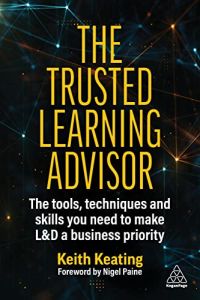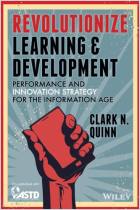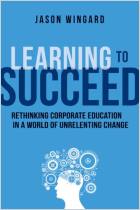Rejoignez getAbstract pour lire le résumé !

Rejoignez getAbstract pour lire le résumé !
Keith Keating
The Trusted Learning Advisor
The Tools, Techniques and Skills You Need to Make L&D a Business Priority
Kogan Page, 2023
Aperçu
Transform your L&D department into a pivotal player in your organization’s business strategy.
Recommendation
Too often, L&D professionals stand on the periphery of their organizations’ business strategy – taking orders rather than acting as collaborative partners. In this helpful guide, L&D expert Keith Keating explains how readers can make corporate learning a strategic business cornerstone by becoming “Trusted Learning Advisors.” Keating provides a wealth of tools and techniques to help L&D leaders build strong stakeholder relationships, develop a deep understanding of business needs, and position themselves as indispensable in shaping the future of workplace learning and performance.
Take-Aways
- Learning and Development departments should act as partners to their companies, not as order-takers.
- Technological tools and business needs constantly evolve, and L&D must keep up.
- Understand the skills necessary to become a Trusted Learning Advisor.
- Build trust with your stakeholders.
- Build a foundational knowledge of L&D departments through practical experience.
- Build your Trusted Learning Advisor toolkit with these best practices.
- Take stakeholders’ orders the right way as a Trusted Learning Advisor.
Summary
Learning and Development departments should act as partners to their companies, not as order-takers.
Today, many people in Learning and Development (L&D) simply follow orders. Stakeholders tell them the problem, decide on a solution, and then expect L&D teams to carry it out without question. However, many L&D practitioners want to change this approach and become “Trusted Learning Advisors.”
When L&D professionals passively take orders from stakeholders, it’s akin to a doctor unquestioningly accepting a patient’s Google diagnosis. As a Trusted Learning Advisor, you don’t merely provide learning services; you function as a strategic partner in the long-term development of an organization’s employees – its most valuable asset. You understand your stakeholders’ primary goals and help them achieve these ends by implementing solutions that create lasting and measurable value.
“A Trusted Learning Advisor holds the key to unlocking performance-driven engagement and fostering creativity and innovation that erases the limits of what an organization can achieve.”
The process of L&D evolving into Trusted Learning Advisors doesn’t happen overnight. It’s a gradual journey marked by small but significant steps and victories. It took one Fortune 500 automobile manufacturer’s L&D team roughly four years to transform from order-takers to Trusted Learning Advisors. The team worked to understand the business better, identifying ways learning strategies could serve its needs. They eliminated redundant programs, gathered qualitative and quantitative data to help with problem-solving and used their findings to propose initiatives to executives. Ultimately, their shift from reacting to business needs to proactively solving problems led to a significant improvement in the company’s services, as evidenced by increased sales, decreased employee turnover and several industry awards.
When L&D doesn’t adopt an advisory role, their organizations keep wasting money on ineffective learning solutions, making stakeholders question L&D’s value. As Trusted Learning Advisors, L&D professionals can drive real change and add significant value to the organization.
Technological tools and business needs constantly evolve, and L&D must keep up.
Change is not the exception but the norm in modern times. L&D’s core value is helping organizational talent adapt to and thrive amid the ever-evolving business environment. But to accomplish this task, L&D itself must meet three significant challenges:
- The need to show value – When you merely take orders, you provide limited value to your organization. On an individual level, providing limited value can lead to disengagement, burnout and reputational damage. It also puts your organization at risk. Repeated failed learning initiatives tend to mean higher operational costs, poorer customer service, and more employee turnover – all of which are bad for a business’s bottom line.
- The growing skills gap – The skills a company needs to serve its customers well continue to evolve quickly, mainly due to rapid technological advancements and the fast pace of digital transformation in businesses. This change has shortened the lifespan of many existing skills. Nearly half of the executives surveyed for LinkedIn’s 2022 Workplace Learning study reported that their workforce lacked the skills to meet business goals. Reskilling and upskilling employees – a core L&D mandate – is a vital element of a company’s continued success.
- The crisis in retaining talented employees – Employees now expect easy access to learning and development services. Deloitte research shows that companies that invest in their workforce’s desire to grow are 30% more likely to become industry leaders. If these needs aren’t met, however, employees are more likely to leave their jobs in search of better opportunities.
“There is no shortage of pitfalls on the path from order taker to Trusted Learning Advisor – the biggest being time.”
If L&D departments can shift from order takers to Trusted Learning Advisors, they have a real chance at addressing these issues and evolving with company needs.
Understand the skills necessary to become a Trusted Learning Advisor.
Transforming into a Trusted Learning Advisor starts with identifying and defining this role’s essential skills and capabilities and then developing a strategy to acquire the necessary skills.
“Ultimately, being a Trusted Advisor is about being committed to providing value within the context of the customer you’re serving.”
Trusted Learning Advisors are honest and bold and can connect deeply with others. They possess expertise and foster partnerships, consistently impressing and satisfying their stakeholders without resorting to selling tactics.
A Trusted Learning Advisor should burnish other skills, too, including:
- Curiosity – Question the status quo and ask why things are the way they are.
- Critical, objective thinking – Learn to analyze data and other information yourself to draw your own conclusions.
- A growth mind-set – Stay open to learning and change.
- Agility – Adapt swiftly to change and gain new skills as needed, such as learning to use new tech tools.
- Empathy – Uncover and work to understand stakeholders’ core needs via active listening.
- Influence – Guide and persuade stakeholders better by understanding both the logical and emotional sides of what they say and do. Remember that cooperation is the goal.
- Creativity – Be innovative and open to adopting new methods, ideas or products that could bring progress.
- Problem-solving – Stay flexible and aim to solve problems as you tackle the many organizational inefficiencies that can block progress, innovation and growth.
Build trust with your stakeholders.
Earning stakeholders’ trust is essential for success as a Trusted Learning Advisor. Gaining and maintaining trust can be challenging, but understanding how human psychology works can improve your chances of building and keeping trust. Trust is emotion-driven. Just one act of self-interest can permanently damage trust, making people see you as someone who does not take others’ needs into account.
“Expertise does not equal trust.”
The five elements of trustworthiness are credibility, reliability, professional intimacy, intention and communication. Combine your knowledge and skills and apply them appropriately to create credibility. Enhance your reliability by fostering a strong moral compass and acting consistently. Build professional intimacy by taking a warm and empathetic approach toward people. Create intention by understanding the purpose behind actions and aligning them with stakeholders’ goals. Finally, build communication by being honest and transparent.
Speed up the trust-building process by gaining a thorough understanding of your business partners, knowing yourself well and having a deep knowledge of the L&D field. Continuously improving these skills is vital for business partners to view you as a reliable and authoritative figure in performance improvement.
Build a foundational knowledge of L&D departments through practical experience.
Becoming a Trusted Learning Advisor in the L&D field demands extensive knowledge and experience. You must understand the theoretical aspects of L&D and gain practical experience. Since the field and its learners continuously change, it’s essential to maintain relevant skills.
“Practitioners don’t just ‘happen’ – they are made.”
One way to track your progress involves using tools like the “L&D Maturity Level” or a skills inventory, which helps evaluate your current abilities and identify areas for improvement.
Assess yourself based on this scale:
- “Training Administrator” – You follow instructions and use pre-existing training content to shape employees according to set standards.
- “L&D Practitioner” – You implement science-backed principles to deliver training more effectively and efficiently, focusing on measuring outcomes.
- “L&D Business Partner” – You immerse yourself in the business, aligning L&D initiatives with business objectives.
- “Learning Consultant” – You are now involved in business discussions, and stakeholders recognize you for your expertise.
- “Trusted Learning Advisor” – You have established a strong brand and secured a significant place in decision-making processes. You have gained stakeholder trust and respect by consistently delivering on promises and demonstrating tangible value.
To enhance your L&D skills, engage in research or fieldwork, undertake stretch assignments, or develop small-scale projects and prototypes. Volunteering, participating in apprenticeships and working with mentors are good ways to gain hands-on experience. Building a diverse toolkit as an L&D practitioner is crucial. This ensures you have a wide range of experiences and exposure to various tools that aid your professional growth and effectiveness.
Build your Trusted Learning Advisor toolkit with these best practices.
Becoming a Trusted Learning Advisor hinges on how you apply yourself and your methods and on your dedication to your development, your learners and your stakeholders.
“Practice, practice, practice.”
Start with developing a Trusted Learning Advisor mind-set: Embrace the need for change and proactively move away from being just an order-taker. Engage with others in the industry, building a network and seeking feedback to gain diverse perspectives and support. Next, develop and shape your personal brand by identifying the unique qualities and strengths you want to be known for in the L&D field. Establish a digital presence, like a personal website or an active LinkedIn profile. Promote your brand through various platforms by writing articles, participating in podcasts and speaking at events. Doing so will increase your visibility and establish yourself as a knowledgeable and trusted professional in the L&D community.
Then, familiarize yourself with various problem-solving methodologies like Agile, design thinking and Lean Six Sigma. Explore diverse learning technologies, case studies and learning theories so you can approach each real-world situation you encounter with a range of tools and strategies at your disposal.
Technology will also play a prominent role in your toolkit, but remember to treat technology as one of many tools, not as the standalone answer. Before choosing any technological solution, L&D practitioners must clearly understand the problem they need to solve and consider if the technology will be useful for learners and supported by the organization’s culture. Bear in mind that solutions that work for one organization may not necessarily work for another due to differences in culture, leadership and context – hence the need for tailored approaches that consider the unique characteristics of each situation. Recognizing these factors will help you stay connected to your learners and keep your expertise sharp.
Take stakeholders’ orders the right way as a Trusted Learning Advisor.
A Trusted Learning Advisor should take stakeholder orders. This might seem paradoxical, but there is a distinction between proactively taking orders and being a passive order-taker. By accepting the initial request, you bolster your relationships with stakeholders and ensure your presence in critical discussions that can lead to meaningful change. It’s a strategic move – part of a larger framework for understanding and supporting stakeholder needs.
“You can only help if you have a seat at the table.”
Handling orders as a Trusted Learning Advisor involves four stages: intake, discovery, analysis and decision. In the intake stage, you receive the order and related details and form a well-defined problem statement. The discovery stage involves thorough research to fully understand the situation and identify the underlying causes of the issue. During the analysis stage, you examine and synthesize the gathered information to confirm the problem statement and develop a course of action. Finally, stakeholders review your plan in the decision stage, and you collectively agree on the best solution to address the problem. Handling orders in this way ensures your input in the problem-solving process and positions you as the go-to problem-solver and expert.
About the Author
Dr. Keith Keating is a chief learning and talent officer who has worked with numerous Fortune 500 companies.
This document is restricted to personal use only.


















Comment on this summary